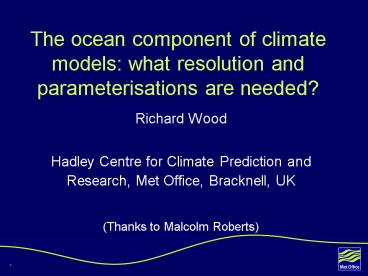The ocean component of climate models: what resolution and parameterisations are needed
1 / 29
Title:
The ocean component of climate models: what resolution and parameterisations are needed
Description:
1. The ocean component of climate models: what resolution and ... Hadley Centre for Climate Prediction and Research, Met Office, Bracknell, UK ... –
Number of Views:42
Avg rating:3.0/5.0
Title: The ocean component of climate models: what resolution and parameterisations are needed
1
The ocean component of climate models what
resolution and parameterisations are needed?
- Richard Wood
- Hadley Centre for Climate Prediction and
Research, Met Office, Bracknell, UK - (Thanks to Malcolm Roberts)
2
Atlantic Ocean Heat Transports
HadCEM
HadCM3
3
Do atmospheric processes set ENSO period? (1)
(Guilyardi et al. 2002)
4
Do atmospheric processes set ENSO period? (2)
(Guilyardi et al. 2002)
5
Do ocean processes set ENSO amplitude? (1)
(Meehl et al. 2001)
6
Do ocean processes set ENSO amplitude? (2)
(Meehl et al. 2001)
7
Temperature drifts - ocean only model
0m
147m
520m
289m
A PCM B add KPP mixing C add GM D add
Visbeck et al. (Gent et al . 2002)
8
Temperature drifts - coupled model
0m
147m
147m
289m
520m
AC PCM AD add KPP mixing GM Visbeck et
al. (Gent et al . 2002)
9
Do we need eddy resolving climate models?
- Dynamical length-scale - baroclinic Rossby radius
- 20-50 km in ocean at mid-latitudes, of order
1000 km in atmosphere - Most climate models have ocean resolution more
coarse than 1 - Oceanic processes possibly important for climate
- boundary currents and ocean eddies - 30-50 km -
heat and freshwater transport - flow through topographic channels (20-50 km) and
impact on thermohaline circulation - tropical dynamics and representation of
equatorial waves - convective regions often pre-conditioned by
eddies - water mass ventilation may be resolution
dependent - coastal polynyas - 10s km - regions of sea-ice
formation
10
Thermocline ventilation in two ocean models
1
1/3
Tracer
PV
(Cox 1985)
11
A systematic study of the effects of ocean
resolution on climate simulations
Results from 3 coupled models HadCM3 Ocean
resolution 1.25x1.25xL20 HadCEML Ocean
resolution 1.25x1.25xL40 HadCEM Ocean
resolution 0.33x0.33xL40 All ocean models are
coupled to the identical atmosphere, resolution
2.5x3.75xL19. No flux adjustments used
12
Dependence of global heat balance on ocean
advection scheme and resolution
13
HadCEM model drifts
14
SST errors
HadCEM
HadCM3
15
North Atlantic salinity drifts in 3 coupled models
0m 2000m 4000m 0m 2000m 4000m 0m
2000m 4000m
HadCEM
0 yrs
150 yrs
-0.45 psu
0.45 psu
HadCEML
HadCM3
16
HadCEM Atlantic Overturning
17
HadCEM Ocean Heat Transports
18
Atlantic Ocean Heat Transports
HadCEM
HadCM3
19
Pacific Ocean Heat Transports
20
Instability Waves in Tropical Pacific (HadCEM)
(Maybe these can be parameterised?) Does the
atmosphere model see them?
21
Salinity and velocity at 260m in HadCEM
(Parameterise these!)
22
Global mean SST response to increasing CO2 in 3
coupled models
23
The future?
24
Impact of inhomogeneous diapycnal mixing
(Hasumi Suginohara 1999)
Homogeneous
Inhomogeneous
Hor. Average (INHM)
25
Mesh adaptivity flow over seamount
(Courtesy Matthew Piggott, Imperial College)
26
Supercomputer performance
(Source Earth Simulator Centre)
27
Current technological issues
- Typical atmosphere GCM has about 6x the
computational cost of typical ocean GCM per
gridpoint - A multicentury ocean integration at 0.1
resolution is a significant cost, even on a 40
Tflop computer - Inclusion of biogeochemical processes can
increase the cost of atmosphere and ocean
dramatically - Mass data storage and methods of data sharing may
become the limiting technologies
28
Summary
- Ocean-only modelling studies give valuable
insights into model sensitivities - but coupling
brings surprises! - Sensitivity to some parameterisations/model
formulations can be resolution-dependent - Increasing resolution doesnt automatically give
a better climate simulation - Large scale climate response fairly insensitive
to ocean resolution. Need compatible atmospheric
and ocean resolutions? - Future higher resolution (-parameterisations?),
diapycnal mixing, biogeochemistry, more flexible
numerical methods, (technological limiters) - and more integration with observations!
- Balance between model diversity and spreading too
thinly
29
(No Transcript)































